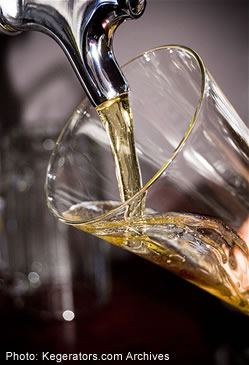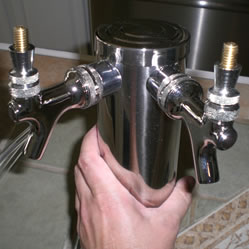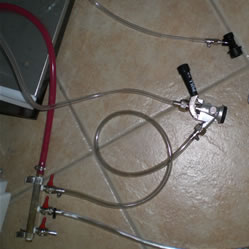Ah, to enjoy a cold draught beer after a long day of work or play – and in the comfort of your own home. Kegerators can make any gathering more special, whether it is a night of music, movies, gaming, or football. Finding the tight kegerator for your home can make all the difference, and they are essential appliances for the home bar, whether it be in the den or a speakeasy-style basement bar. For home brewers, kegerators are the perfect choice for serving your kegged home brew.
Canned and bottled beers are great – but they run out so quickly. They also take up a lot of space in the fridge. This is why kegerators make such great additions to any beer fan’s home, whether you are a home brew hobbyist, a craft beer enthusiast, or just a fan of beer. Draft beer just tastes better, especially at home.
 |
The best thing about having a kegerator around is when company comes over. To be able to say to friends,
“Help yourself to as much beer as you want – the kegerator is right over there!”
That is a beautiful moment. I remember my first night of kegerator drinking. I believe it was Austin, TX micro brewery Live Oak’s Big Bark Amber Ale. My host was generous, and the beer cold and tasty – thanks to his kegerator. It certainly made that visit “just to say hi” much more special.
Buying a kegerator doesn’t have to be expensive, either. Kegerator conversion kits can turn that old fridge that you don’t know what to do with into a useful appliance. They are available for $50 to $250, depending on what design elements you wish to incorporate. You can even put that top compartment freezer to use keeping pint glasses and mugs nice and frosty.
If you are looking for something pre-packaged, you can still get a mini kegerator for as little as $100. These mini kegerators dispense store bought mini kegs of the five and six liter variety with optimum ease. Some even dispense the beer with CO2, supplied via cartridge, to ensure that your mini keg beer keeps for up to 30 days. But one party and that mini keg is toast, trust me. If the beer has not been drank after 30 days, you are doin’ it wrong!
Most kegerators have the capacity to serve at least one 15 1/2 gallon keg of beer at time. With pony kegs or soda kegs, and multi-taps, you can even have more than one beer on tap at one time. Some kegerators come with four or more beer taps. That’s better than a lot of bars!
Kegerators are also highly customizable. If you want more taps, you can always add them later. Tap handles are another way to customize your kegerator. Put tap handles of your favorite beers on your kegerator, or make custom ones out of a gear shifter or a My Little Pony. I have even seen someone take a wooden wine barrel and use it to build a façade around their kegerator to make a most convincing and entertaining illusion that the beer flowed up right from a wooden keg. You can equip your kegerator with a nitrogen system for smoother draughts or add a filtration system for clearer pints. Spice up your kegerator with custom skins or beer decals.
Whether mini or full sized kegerator is for you, the benefits of having draft beer at home remain the same: make your home more hospitable, have better parties, and never be short of beer, even on Sunday. A kegerator in your home bar is a definite plus, whether on game day or for a great birthday party. All of this is what makes kegerator beer so special.




